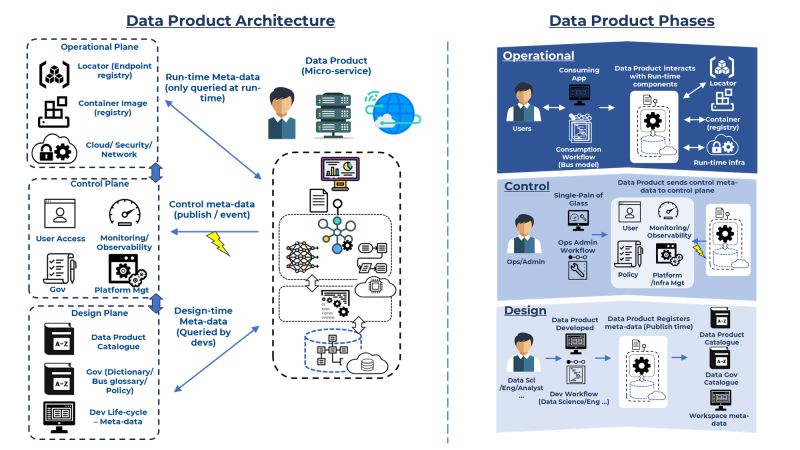In the realm of micro-service (MS) oriented data products (DPs), understanding and categorizing metadata is crucial for success. Metadata, the data about data, plays a vital role in building, controlling, and operating data products. Effective management of metadata ensures efficient, secure, and scalable data products.
The Three Core Types of Metadata
Data products typically have three core types of metadata:
Design Metadata 🎨:
- Purpose: Vital for building data products.
- Components: Schemas, model definitions, hyperparameters, etc.
- Function: Acts as the blueprint of your data product, guiding its creation and structure.
Control Metadata 🔧:
- Purpose: Essential for monitoring and administering data products in production.
- Components: Logging, error tracking, resource usage metrics, and more.
- Function: Ensures smooth operation by providing insights into the system’s health and performance.
Operational Metadata ⚙️:
- Purpose: Critical for the actual running of data products at runtime.
- Components: Endpoint addresses for execution in production contexts.
- Function: Supports the core function of each data product, typically machine-readable and part of the production infrastructure.
🚫 Mixing or compressing these can lead to inefficiencies and security risks.
Lifecycle Phases of Metadata
Data products go through three main lifecycle phases, each associated with specific metadata needs:
Design Time:
- Focus: Building data products.
- Metadata Components: Data definitions, application templates, policy definitions.
- User Interaction: Developers interact with components like data product catalogs, app template definitions, and configuration catalogs.
Control:
- Focus: Management, observability, and control of data products.
- Metadata Components: Logging, audit, and observability data.
- User Interaction: Ops/Admins use control plane interfaces to monitor resource usage, usability metrics, adoption rates, errors, and audit points. Data products publish events to control plane components to avoid impacting runtime operations.
Operation:
- Focus: Efficient and secure running of data products in production.
- Metadata Components: Service locators for endpoint discovery.
- User Interaction: System or end-user interaction. The focus is on mission-critical operations with low-touch maintenance.
Ensuring Efficient Metadata Management
To ensure efficiency and security, it’s crucial to separate these components and respect their unique functions across different lifecycle phases:
- Access Patterns: Different metadata types have distinct access patterns (e.g., point lookup vs. browse).
- Operational Profiles: Ensuring design time operations don’t slow down runtime operations.
- Security Profiles: Protecting against unauthorized access in different environments.
Leveraging Metadata for a Robust Data Product Ecosystem
When data products are published or updated, they register in the data product catalog, similar to a Configuration Management Database (CMDB). This registration process ensures that data products, whether running or not, are discoverable and integrable. When spun up, data products publish their endpoints to the service locator, akin to DNS, facilitating efficient discovery and integration.
By maintaining clear distinctions between design, control, and operational metadata and leveraging appropriate technologies for each type, organizations can build a secure, efficient, and effective data product ecosystem.
Enhancing Metadata Management with Automation and Governance
To further elevate the value of data products:
Automated Metadata Management:
- Implement tools to streamline categorization and updates.
- Introduce AI for smarter schema changes and security monitoring, reducing manual efforts and increasing business responsiveness.
Strong Governance Framework:
- Ensure compliance and enhance data product reliability.
- Foster a collaborative culture among stakeholders regarding metadata practices to drive continuous improvement in the data product ecosystem.
Personalized User Experiences:
- Different personas (e.g., ops/admins vs. data product owners) have unique needs. Design user journeys that cater to these differences, ensuring quick access to relevant data and insights.
Conclusion
Metadata management is a critical aspect of building and operating micro-service-oriented data products. By understanding the different types of metadata and their lifecycle phases, and by implementing robust automation and governance strategies, organizations can create a scalable, secure, and efficient data product ecosystem. This approach not only enhances operational efficiency but also drives innovation and business success.
Call to Action
For more information on how to optimize your data product metadata management, contact us at Dataception Ltd.


